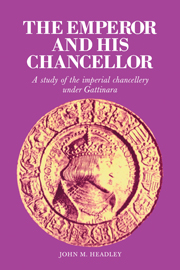Book contents
- Frontmatter
- Contents
- Acknowledgments
- List of abbreviations
- Introduction
- 1 The administrative threshold
- 2 The emerging government of Charles V
- 3 The conflict between chancellor and emperor
- 4 The imperial chancellery
- 5 The imperial propaganda campaign of 1526–1527
- 6 The last years of the chancellorship
- Epilogue
- Appendix 1 The Summary by Philippe Hanneton, audiencier of the Burgundian chancellery, regarding the office of the Grand Chancellor
- Appendix II ‘The Doubts of [Alonso de] Soria’, lieutenant protonotary, concerning Gattinara's proposals for reforming the Aragonese chancellery
- Appendix III Gattinara's ‘Brussels Remonstrance’
- Appendix IV Gattinara's proposals for the more effective operation of the Council of State
- Appendix V A comparative analysis of the movements of the imperial court and the imperial chancellery 1518–1530
- Bibliography
- Index
5 - The imperial propaganda campaign of 1526–1527
Published online by Cambridge University Press: 07 October 2011
- Frontmatter
- Contents
- Acknowledgments
- List of abbreviations
- Introduction
- 1 The administrative threshold
- 2 The emerging government of Charles V
- 3 The conflict between chancellor and emperor
- 4 The imperial chancellery
- 5 The imperial propaganda campaign of 1526–1527
- 6 The last years of the chancellorship
- Epilogue
- Appendix 1 The Summary by Philippe Hanneton, audiencier of the Burgundian chancellery, regarding the office of the Grand Chancellor
- Appendix II ‘The Doubts of [Alonso de] Soria’, lieutenant protonotary, concerning Gattinara's proposals for reforming the Aragonese chancellery
- Appendix III Gattinara's ‘Brussels Remonstrance’
- Appendix IV Gattinara's proposals for the more effective operation of the Council of State
- Appendix V A comparative analysis of the movements of the imperial court and the imperial chancellery 1518–1530
- Bibliography
- Index
Summary
Standing at the headwaters of bureaucratic differentiation, the late medieval chancellery exercised an amalgam of functions–judicial, diplomatic, administrative–that later ages would gradually sort out into discrete departments. Certainly by 1500 the properly judicial aspect had been so clearly distinguished as to be removed from the more secretarial functions of the chancellery. Within the latter branch the chancellor, as official spokesman of the ruler, could expect at a moment of crisis or accelerated diplomatic activity to exercise the functions of a propagandist for his monarch. Examples of medieval chancellors consciously acting as propagandists, if not many, are still significant: one thinks of the imperial brilliance of the Hohenstaufen chancellery under Rainald von Dassel and Piero della Vigna; or more recently the Florentine chancellery under the direction of Coluccio Salutati whose missives trumpeted the majesty and virtue of the infant Arno republic from the Baltic to the Bosphorus. In his exercise of an acknowledged monopoly of official rhetoric the chancellor sought to promote the prince or polity that he served. It is in this tradition that we need ultimately to judge the feverish activity of Charles V's Grand Chancellor within his chancellery during the latter half of 1526. Moreover, the crisis created in imperial affairs by the League of Cognac had the dual effect of reconfirming the role and policies of Gattinara and of allowing his chancellery to operate as a fairly coherent body for what would appear to be the last time.
- Type
- Chapter
- Information
- The Emperor and His ChancellorA Study of the Imperial Chancellery under Gattinara, pp. 86 - 113Publisher: Cambridge University PressPrint publication year: 1983



